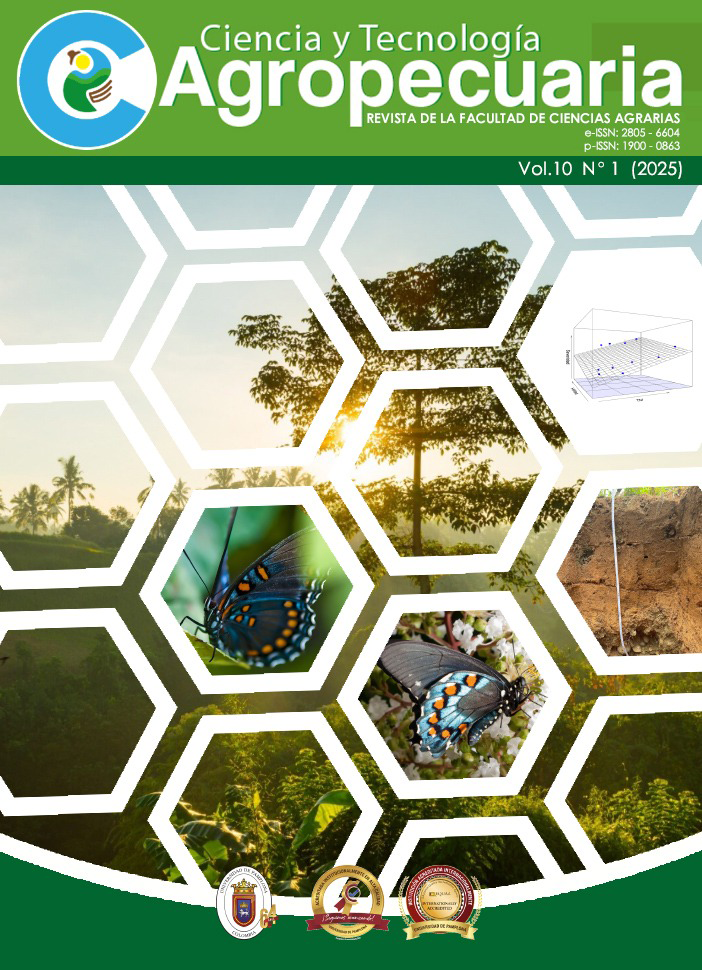Mathematical modeling of the severity of Cercospora leaf spot of chard as a function of meteorological variables
DOI:
https://doi.org/10.24054/cyta.v10i1.3647Keywords:
Epidemiology, Cercospora beticola, multiple linear regressionAbstract
Chard (Beta vulgaris subsp cicla L.), is a plant rich in nutrients such as vitamins, minerals, antioxidants and dietary fibers, however, its cultivation faces challenges due to the lack of technology and, caused by the fungus Cercospora beticola. This research aimed to model the severity of Cercospora leaf spot of chard based on meteorological variables under environmental conditions in the garden of the Escuela Normal Superior de Pamplona (Norte de Santander; Colombia). The assessment of the progress of the disease was developed by evaluating the crop every seven (7) days over time to relate them to the meteorological variables. Seven climatic variables were considered, which were processed for seven days prior to each sample to obtain the maximum, average and minimum temperature, maximum, average and minimum weekly relative humidity, weekly accumulated rainfall and rainy days in those seven days. The Pearson score showed strong and moderate positive linear relationships between disease severity and climatic variables for the two periods of February and March sowing date. From the multiple linear regression model, highly significant relationships were obtained that explain the variability of the severity of Cercospora leaf spot in the crop such as: TM, HRMAX, HRM and TMAX for the February sowing date and TMAX, TM and HRM for the March sowing date, with R2 with reliability above 90% on the February sowing date and 90% on the March date depending on the climatic variables.
Downloads
References
Bombelli, E. C., Moschini, R., Wright, E. R., López, M. V., & Fabrizio, M. D. C. (2013). Modeling for the prediction of diseases in crops of high commercial value. Projections, 11(1), 47–60.
Cabral, R. N., Marouelli, W. A., Lage, D. A., & Café-Filho, A. C. (2013). Septoria leaf spots in organic tomatoes under diverse irrigation systems and water management strategies. Horticultura Brasileira, 31, 392–400. DOI: https://doi.org/10.1590/S0102-05362013000300009
Castellanos, L., Rivero, T., Porras, A., & Pajón, J. (2005). Mathematical modeling of Alternaria solani Sor. in potatoes depending on meteorological variables and the age of the crop. Fitosanidad, 9(1), 7–14.
Castellanos, L. (2013). El cambio climático y las enfermedades de las plantas. Agroecosistemas, 1(2). https://aes.ucf.edu.cu/index.php/aes/article/view/52
Ciba-Geigy, B. (1981). Manual para ensayos de campo en protección vegetal (2.ª ed. revisada y ampliada). Basilea, Suiza.
Ebert, M. K., Rangel, L. I., Spanner, R. E., Taliadoros, D., Wang, X., Friesen, T. L., de Jonge, R., Neubauer, J. D., Secor, G. A., Thomma, B. P. H. J., Stukenbrock, E. H., & Bolton, M. D. (2021). Identification and characterization of
Cercospora beticola necrosis-inducing effector CbNip1. Molecular Plant Pathology, 22(3), 301–316. https://doi.org/10.1111/MPP.13026 DOI: https://doi.org/10.1111/mpp.13026
Espinoza, G. (2020). Acelga, Beta vulgaris var. cicla, características, cultivo y propiedades. Naturaleza y Ecología. https://naturaleza.animalesbiologia.com/plantas/verduras/acelga-beta-vulgaris-var-cicla
ICA. (2013). Acelga colombiana llegará a Estados Unidos. CONtexto Ganadero. https://www.contextoganadero.com/agricultura/acelga-colombiana-llegara-estados-unidos
Ivancovich, A., & Lavilla, M. A. (2016). Propuestas de escalas para la evaluación, a campo y en laboratorio, del “tizón foliar” y la “mancha púrpura de la semilla”, causadas por Cercospora kikuchii, en soja. Engormix. https://www.engormix.com/agricultura/articulos/propuestas-escalas-evaluacion-campo-t40660.htm
Lavilla, M., Martínez, M., Ivancovich, A., & Díaz-Paleo, A. (2023). Predictive model of the severity of leaf blight caused by Cercospora kikuchii using meteorological variables. Mesoamerican Agronomy, 34(3), 54430–54430. DOI: https://doi.org/10.15517/am.2023.54430
Marcuzzo, L. L., Harbs, S. C., & Nascimento, A. (2021). Caracterização da epidemiologia temporal e espacial da cercosporiose da beterraba. Summa Phytopathologica, 46(4), 348–350. https://doi.org/10.1590/0100-5405/189360 DOI: https://doi.org/10.1590/0100-5405/189360
Mzoughi, Z., Chahdoura, H., Chakroun, Y., Cámara, M., Fernández-Ruiz, V., Morales, P., Mosbah, H., Flamini, G., Snoussi, M., & Majdoub, H. (2019). Wild edible Swiss chard leaves (Beta vulgaris L. var. cicla): Nutritional, phytochemical composition and biological activities. Food Research International, 119, 91–99. https://doi.org/10.1016/j.foodres.2018.10.039 DOI: https://doi.org/10.1016/j.foodres.2018.10.039
Onion, I. (2008). Análisis temporal de la pudrición blanca (Sclerotium cepivorum Berk.) de la cebolla (Allium cepa L.) bajo tres niveles de inóculo del patógeno. Agrociencia, 42(1), 71–83.
Rangel, L. I., Spanner, R. E., Ebert, M. K., Pethybridge, S. J., Stukenbrock, E. H., de Jonge, R., Secor, G. A., & Bolton, M. D. (2020). Cercospora beticola: The intoxicating lifestyle of the leaf spot pathogen of sugar beet. Molecular Plant Pathology, 21(8), 1020–1041. https://doi.org/10.1111/MPP.12962 DOI: https://doi.org/10.1111/mpp.12962
Rodríguez, C. J., Varón, F., Villalobos, S. J. C., & Parody, R. J. A. (2022). Manual de enfermedades y plagas del maíz. ResearchGate. https://www.researchgate.net/publication/359746663_Manual_de_enfermedades_y_plagas_del_maiz
Salas Espinoza, J. L. (2019). Manejo de nutrición considerando capacidad de extracción de fertilizantes en la producción de acelga (Beta vulgaris). Universidad Autónoma Agraria Antonio Narro. http://repositorio.uaaan.mx:8080/xmlui/bitstream/handle/123456789/46451/K%2066045%20Salas%20Espinoza%2C%20Jorge%20Luis.pdf?sequence=1&isAllowed=y.
Downloads
Published
How to Cite
Issue
Section
License
Copyright (c) 2025 Brayham Jhayr Rodríguez Moreno, Leónides Castellanos González, Carmen Omaira Rozo García

This work is licensed under a Creative Commons Attribution-NonCommercial-ShareAlike 4.0 International License.










